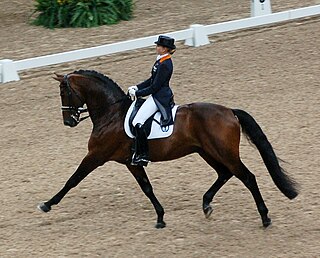
Dressage is a form of horse riding performed in exhibition and competition, as well as an art sometimes pursued solely for the sake of mastery. As an equestrian sport defined by the International Equestrian Federation, dressage is described as "the highest expression of horse training" where "horse and rider are expected to perform from memory a series of predetermined movements".
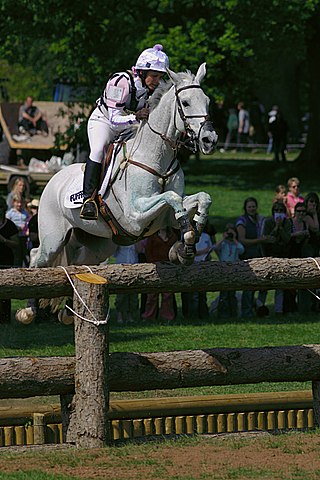
Eventing is an equestrian event where a single horse and rider combine and compete against other competitors across the three disciplines of dressage, cross-country, and show jumping. This event has its roots in a comprehensive cavalry test that required mastery of several types of riding. The competition may be run as a one-day event (ODE), where all three events are completed in one day or a three-day event (3DE), which is more commonly now run over four days, with dressage on the first two days, followed by cross-country the next day and then show jumping in reverse order on the final day. Eventing was previously known as Combined Training, and the name persists in many smaller organizations. The term "Combined Training" is sometimes confused with the term "Combined Test", which refers to a combination of just two of the phases, most commonly dressage and show jumping.

Equestrianism, commonly known as horse riding or horseback riding, includes the disciplines of riding, driving, and vaulting. This broad description includes the use of horses for practical working purposes, transportation, recreational activities, artistic or cultural exercises, and competitive sport.

The Hanoverian is a Warmblood horse breed originating in Germany, which is often seen in the Olympic Games and other competitive English riding styles, and has won gold medals in all three equestrian Olympic competitions. It is one of the oldest, most numerous, and most successful of the Warmblood breeds. Originally a cavalry horse, infusions of more Thoroughbred blood lightened it to make it more agile and useful for competition. The Hanoverian is known for a good temperament, athleticism, beauty, and grace.

A horse show is a judged exhibition of horses and ponies. Many different horse breeds and equestrian disciplines hold competitions worldwide, from local to the international levels. Most horse shows run from one to three days, sometimes longer for major, all-breed events or national and international championships in a given discipline or breed. Most shows consist of a series of different performances, called classes, wherein a group of horses with similar training or characteristics compete against one another for awards and, often, prize money.
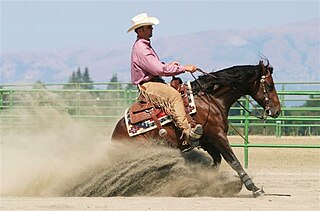
Reining is a western riding competition for horses where the riders guide the horses through a precise pattern of circles, spins, and stops. All work is done at the lope, or the gallop. Originating from working cattle, reining requires the horse to be responsive and in tune with its rider, whose aids should not be easily seen, and judges the horse on its ability to perform a set pattern of movements. The horse should be willingly guided or controlled with little or no apparent resistance and dictated to completely. A horse that pins his ears, conveys a threat to his rider, refuses to go forward, runs sideways, bounces his rear, wrings his tail in irritation, or displays an overall poor attitude is not being guided willingly, and is judged accordingly.If a horse jogs or breaks gait it is a 0.

Equitation is the art or practice of horse riding or horsemanship.
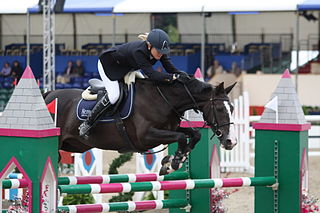
The Selle Français (SF) is a breed of sport horse from France. An athletic horse with good gaits, it is usually bay or chestnut in color. The Selle Français was created in 1958 when several French riding horse breeds were merged into one stud book. The new breed was meant to serve as a unified sport horse during a period when horses were being replaced by mechanization and were transforming into an animal used mainly for sport and leisure.
The United States Equestrian Team (USET) refers to the American national teams in Olympic and non-Olympic disciplines of horse sport. US Equestrian, the governing body of horse sport in the United States, selects, trains and funds the teams. The Olympic discipline teams are: the Land Rover US Eventing Team, the Dutta Corp. US Dressage Team and the NetJets US Jumping Team. The United States also fields teams in para-dressage, combined driving, endurance, reining and vaulting. USET has a history of Olympic success, with fifty-two medals - eleven gold, twenty-one silver and twenty bronze across the three Olympic disciplines.
Anne Kindig Kursinski is an American showjumper and two-time Olympic silver medalist in team jumping, at Seoul 1988 and Atlanta 1996. Representing the United States, she was a member of five Olympic teams, forty-seven Nations Cup teams, and three World Equestrian Games teams. In 2017, she was inducted into the Showjumping Hall of Fame.
James Cunningham Wofford was an American equestrian who competed in many international competitions in the sport of eventing. He was most known as a trainer of both horses and riders, and as a retired president of the AHSA and vice-president of the USET.
Brentina was an Olympic-level dressage horse ridden by Debbie McDonald. She was owned by E. Parry Thomas.
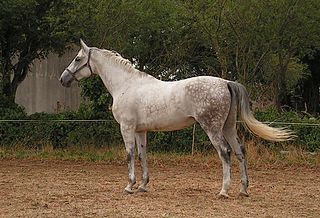
A sport horse or sporthorse is a type of horse, rather than any particular breed. The term is usually applied to horses bred for the traditional Olympic equestrian sporting events of dressage, eventing, show jumping, and combined driving, but the precise definition varies. In the United States, horses used in hunt seat and show hunter competition are often classed as sport horses, whereas the British show hunter is classified as a "show horse."
Robert Jeffrey Dover is an American equestrian who has had international success in the sport of dressage. Riding from the age of 13, he began specializing in dressage at age 19 and competed in his first Olympics in 1984. He competed in every summer Games between 1984 and 2004, winning four team bronze medals. He also took a team bronze at the 1994 World Equestrian Games. Dover is the most honored dressage rider in the United States, and has been inducted to the United States Dressage Federation Hall of Fame. Outside of competition, Dover founded the Equestrian Aid Foundation in 1996 to assist others in the equestrian world, and hosted a TV show that searched for the next dressage star. From late 2009 to early 2011, Dover served as the Technical/Coach Advisor for the Canadian national dressage team. In April 2013, Dover was named Technical Advisor/Chef d'Equipe for the US national dressage team.
George H. Morris is an American equestrian. He won team silver in show jumping at the 1960 Rome Olympics and is considered a founding father of hunt seat equitation. He was chef d'equipe for the United States show jumping team, which won Olympic gold under his leadership, from 2005 until 2013. He also served as chef d'equipe for the Brazilian show jumping team at the 2016 Rio Olympics. Throughout his career, Morris has been a "proponent of the forward seat" and wrote several books on the subject, including Hunter Seat Equitation. Morris trained students at his Hunterdon Stables and traveling clinics, producing nationally and internationally successful riders, including Olympic champions. In 2019, after a United States Center for SafeSport investigation, Morris was banned for life from the United States Equestrian Federation (USEF) due to sexual misconduct with minors. Morris is likewise banned from coaching international teams for any country.
The Arabian Horse Association (AHA) is a national organization that registers Arabian horses in the United States. It also works with the United States Equestrian Federation to sanction horse shows and license judges for Arabian horses.

Horse Sport Ireland (HSI) is the national governing body for all equestrian sport for Ireland. Established in 2008, it is responsible for the administration of international competitions throughout the island, including the Republic of Ireland and Northern Ireland. It sanctions Irish riders and horses competing abroad at international events, and implements the rules and regulations laid down by the FEI. It is recognised by FEI, Sport Ireland, and the Olympic Federation of Ireland.

Meredith Sue Hodges is an American equine trainer, competitor, educator, author and TV personality specializing in mules and donkeys, specifically the contemporary saddle mule.

Steffen Peters is a German-born equestrian who competes for the United States in dressage. He has participated in five Olympic Games, winning a team bronze medal on two occasions and a team silver medal once (2020). Peters has been successful in numerous other international competitions, including winning team bronze at the 2006 World Equestrian Games, two individual bronze medals at the 2010 World Equestrian Games and individual and team gold medals at both 2011 and 2015 Pan Am Games. The horse upon which he won many of his titles, Ravel, was retired in 2012. After 2012, his international successes came on Legolas. At the beginning of 2017, Peters handed over the ride on Legolas to his assistant rider Dawn White-O'Connor. Peters is currently working with a new international competition horse, Rosamunde.
Bernie Traurig is an American equestrian known for his international success in show jumping, dressage and eventing, as well as his coaching and training career. He is the founder of Equestrian Coach, an educational website.












